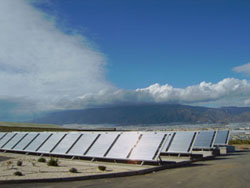Exploiting the sun to purify water in remote regions
A significant portion of the world's population lacks access to safe drinking water. The problem is particularly acute in developing nations. A research project supported by the INCO 2 Programme brought together experts from around the Mediterranean to seek a solution. The challenge was to develop an autonomous system that could purify contaminated water, making it fit for consumption, in regions where no electricity is available. The AQUACAT partners turned to the sun, specifically a system based on a solar reactor. Advanced catalysts made from titanium oxide and ruthenium replace traditional methods of water purification such as chlorine. The unit incorporates solar collectors, a storage tank and pump, a data logger and all the necessary connectors and wiring. It is housed in a stainless steel frame built to survive the most inhospitable operating conditions. Water is treated in a batch mode, up to thirty litres at a time. During AQUACAT, two different prototypes were assembled and tested on water samples infected with Escherichia coli and Enterococcus faecalis. The results were impressive as bacteria levels were reduced by two to three orders of magnitude. A slight advantage was detected for the model outfitted with a fin-shaped solar collector. The organisations involved in AQUACAT acquired significant experience and expertise during the project. It is hoped that this knowledge will be applied to other solar technology applications, such as water heating, in the future.



